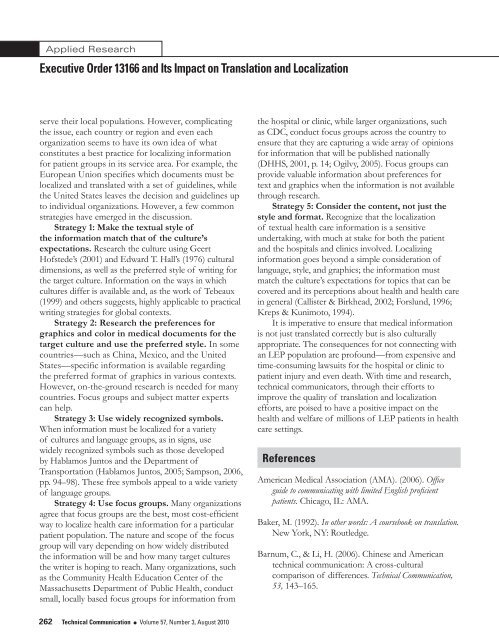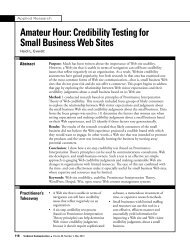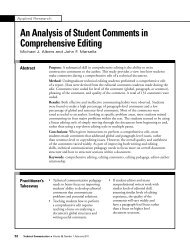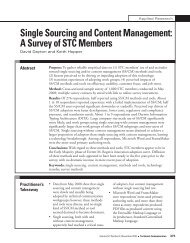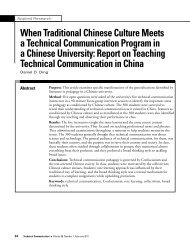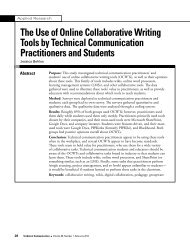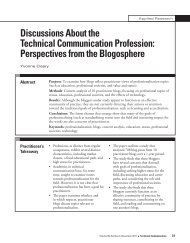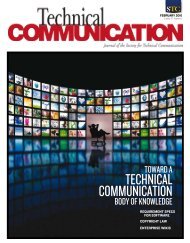Applied ResearchExecutive Order 13166 and Its Impact on Translation and Localizationserve their local populations. However, complicatingthe issue, each country or region and even eachorganization seems to have its own idea of whatconstitutes a best practice for localizing informationfor patient groups in its service area. For example, theEuropean Union specifies which documents must belocalized and translated with a set of guidelines, whilethe United States leaves the decision and guidelines upto individual organizations. However, a few commonstrategies have emerged in the discussion.Strategy 1: Make the textual style ofthe information match that of the culture’sexpectations. Research the culture using GeertHofstede’s (2001) and Edward T. Hall’s (1976) culturaldimensions, as well as the preferred style of writing forthe target culture. Information on the ways in whichcultures differ is available and, as the work of Tebeaux(1999) and others suggests, highly applicable to practicalwriting strategies for global contexts.Strategy 2: Research the preferences forgraphics and color in medical documents for thetarget culture and use the preferred style. In somecountries—such as China, Mexico, and the UnitedStates—specific information is available regardingthe preferred format of graphics in various contexts.However, on-the-ground research is needed for manycountries. Focus groups and subject matter expertscan help.Strategy 3: Use widely recognized symbols.When information must be localized for a varietyof cultures and language groups, as in signs, usewidely recognized symbols such as those developedby Hablamos Juntos and the Department ofTransportation (Hablamos Juntos, 2005; Sampson, 2006,pp. 94–98). These free symbols appeal to a wide varietyof language groups.Strategy 4: Use focus groups. Many organizationsagree that focus groups are the best, most cost-efficientway to localize health care information for a particularpatient population. The nature and scope of the focusgroup will vary depending on how widely distributedthe information will be and how many target culturesthe writer is hoping to reach. Many organizations, suchas the Community Health Education Center of theMassachusetts Department of Public Health, conductsmall, locally based focus groups for information fromthe hospital or clinic, while larger organizations, suchas CDC, conduct focus groups across the country toensure that they are capturing a wide array of opinionsfor information that will be published nationally(DHHS, 2001, p. 14; Ogilvy, 2005). Focus groups canprovide valuable information about preferences fortext and graphics when the information is not availablethrough research.Strategy 5: Consider the content, not just thestyle and format. Recognize that the localizationof textual health care information is a sensitiveundertaking, with much at stake for both the patientand the hospitals and clinics involved. Localizinginformation goes beyond a simple consideration oflanguage, style, and graphics; the information mustmatch the culture’s expectations for topics that can becovered and its perceptions about health and health carein general (Callister & Birkhead, 2002; Forslund, 1996;Kreps & Kunimoto, 1994).It is imperative to ensure that medical informationis not just translated correctly but is also culturallyappropriate. The consequences for not connecting withan LEP population are profound—from expensive andtime-consuming lawsuits for the hospital or clinic topatient injury and even death. With time and research,technical communicators, through their efforts toimprove the quality of translation and localizationefforts, are poised to have a positive impact on thehealth and welfare of millions of LEP patients in healthcare settings.ReferencesAmerican Medical Association (AMA). (2006). Officeguide to communicating with limited English proficientpatients. Chicago, IL: AMA.Baker, M. (1992). In other words: A coursebook on translation.New York, NY: Routledge.Barnum, C., & Li, H. (2006). Chinese and Americantechnical communication: A cross-culturalcomparison of differences. Technical Communication,53, 143–165.262 Technical Communication l Volume 57, Number 3, August 2010
Applied ResearchNicole St. Germaine-McDanielBarrett, S., Dyer, C., & Westpheling, K. (2008). Languageaccess: Understanding the barriers and challenges in primarycare settings. McLean, VA: Association of Cliniciansfor the Underserved.Browner, C. H., & Press, N. (1997). The productionof authoritative knowledge in American prenatalcare. In R. E. Davis-Floyd & C. F. Sargent (Eds.),Childbirth and authoritative knowledge (pp. 113–131).Berkeley, CA: University of California Press.Callister, L. C., & Birkhead, A. (2002). Acculturation andperinatal outcomes in Mexican immigrant women:An integrative review. Journal of Perinatal and NeonatalNursing, 16(3), 22–38.Clinton, W. J. (2000). Executive order 13166: Improvingaccess to services for persons with limited Englishproficiency. Retrieved March 22, 2007, from http://www.usdoj.gov/crt/cor/Pubs/eolep.htmCommittee on Health, Education, Labor, and Pensions.(2002). Hispanic health: Problems with coverage, access, andhealth disparities. Washington, DC: U.S. GovernmentPrinting Office.Condon, J. (1985). Good neighbors: Communicating withMexicans. Yarmouth, ME: Intercultural Press.Cronin, M. (2001). Translation and globalization. New York:Routledge.Downing, B., & Roat, C. (2002). Models for the provision oflanguage access in health care settings. Washington, DC:National Council on Interpreting in Health Care.European Committee for Standardization (CEN).Accessed February 12, 2010, from http://www.cen.eu/CEN/Sectors/sectors/healthcare/Pages/default.aspxForslund, C. J. (1996). Analyzing pictorial messagesacross cultures. In D. C. Andrews (Ed.),International dimensions of technical communication(pp. 45–58). Arlington, VA: Society for TechnicalCommunication.Foucault, M. (1973). The birth of the clinic: An archaeology ofmedical perception. New York, NY: Vintage Books.Hablamos Juntos. 2005. Using symbols. RetrievedOctober 2, 2009 from http://www.hablamosjuntos.org/signage/symbols/default.using_symbols.aspHall, E. T. (1976). Beyond culture. New York, NY: AnchorBooks.Hasnain-Wynia, R., Yonek, J., Pierce, D., Kang, R., &Hedges Greising, C. (2006). Hospital language servicesfor patients with limited English proficiency: Results from anational survey. Washington, DC: Health Research &Educational Trust.Hofstede, G. (2001). Cultures and organizations: Software ofthe mind. New York, NY: McGraw-Hill.Horton, W. (1993). The almost universal language:Graphics for international documents. TechnicalCommunication, 40, 682–693.Jordan, B. (1997). Authoritative knowledge and itsconstruction. In R. E. Davis-Floyd & C. F. Sargent(Eds.), Childbirth and authoritative knowledge (pp.55–79). Berkeley, CA: University of California Press.Kenna, P. (1994). Business Mexico. Lincolnwood, IL: NTCPublishing Group.Kostelnick, C. (1995). Cultural adaptation andinformation design: Two contrasting views. IEEETransactions on Professional Communication, 38, 182–196.Kreps, G. L., & Kunimoto, E. N. (1994). Effectivecommunication in multicultural health care settings.Thousand Oaks, CA: Sage.Limited English proficiency: A federal interagency Website. http://www.lep.govLongo, B. (1998). An approach for applying culturalstudy theory to technical writing research. TechnicalCommunication Quarterly, 7, 53–73.Volume 57, Number 3, August 2010 l Technical Communication 263
- Page 1 and 2: AUGUST 2010Volume 57 Number 3SPECIA
- Page 3 and 4: PresidentMichael A. HughesVice Pres
- Page 5 and 6: VoLuME 57, NuMBER 3AUGUST 2010ISSN
- Page 7 and 8: Guest EditorialKirk St.Amant and Ma
- Page 9 and 10: Applied ResearchTechnical Communica
- Page 11 and 12: Applied ResearchNicole St. Germaine
- Page 13 and 14: Applied ResearchNicole St. Germaine
- Page 15 and 16: Applied ResearchNicole St. Germaine
- Page 17 and 18: Applied ResearchNicole St. Germaine
- Page 19: Applied ResearchNicole St. Germaine
- Page 23 and 24: Applied ResearchNicole St. Germaine
- Page 25 and 26: Applied TheoryTatiana BatovaIntrodu
- Page 27 and 28: Applied TheoryTatiana BatovaMoreno,
- Page 29 and 30: Applied TheoryTatiana BatovaThe Uni
- Page 31 and 32: Applied TheoryTatiana Batovadoctors
- Page 33 and 34: Applied TheoryTatiana BatovaTo addr
- Page 35 and 36: Applied TheoryTatiana Batovathe loc
- Page 37 and 38: Applied TheoryTatiana BatovaJohnson
- Page 39 and 40: Applied TheoryTatiana BatovaInterna
- Page 41 and 42: Applied TheoryMcKee and PorterIntro
- Page 43 and 44: Applied TheoryMcKee and PorterFor e
- Page 45 and 46: Applied TheoryMcKee and Porterpubli
- Page 47 and 48: Applied TheoryMcKee and PorterBecau
- Page 49 and 50: Applied TheoryMcKee and Porterof th
- Page 51 and 52: Applied TheoryMcKee and Porterwith
- Page 53 and 54: Applied TheoryMcKee and PorterA Cop
- Page 55 and 56: Applied TheoryMcKee and PorterConte
- Page 57 and 58: Applied TheoryMcKee and PorterWalto
- Page 59 and 60: Applied ResearchLiza PottsIntroduct
- Page 61 and 62: Applied ResearchLiza Pottsdoes not
- Page 63 and 64: Applied ResearchLiza PottsUser’s
- Page 65 and 66: Applied ResearchLiza Pottsactors, t
- Page 67 and 68: Applied ResearchLiza PottsDRM has a
- Page 69 and 70: Applied ResearchLiza Pottsmake bett
- Page 71 and 72:
Applied ResearchLiza PottsOne viewe
- Page 73 and 74:
Applied ResearchLiza Pottsinvolved
- Page 75 and 76:
Applied ResearchLiza PottsHayhoe, G
- Page 77 and 78:
Applied ResearchInternational Fair
- Page 79 and 80:
Applied ResearchTyAnna K. Herringto
- Page 81 and 82:
Applied ResearchTyAnna K. Herringto
- Page 83 and 84:
Applied ResearchTyAnna K. Herringto
- Page 85 and 86:
Applied ResearchTyAnna K. Herringto
- Page 87 and 88:
Applied ResearchTyAnna K. Herringto
- Page 89 and 90:
Book ReviewsWriting Successful Scie
- Page 91 and 92:
Book ReviewsThe Process: Business P
- Page 93 and 94:
Book ReviewsHCI Beyond the GUI: Des
- Page 95 and 96:
Book ReviewsOrigins of the Specious
- Page 97 and 98:
Book Reviewsgenre, and process, top
- Page 99 and 100:
Book ReviewsPart One goes from the
- Page 101 and 102:
Book Reviewsrather than writers, an
- Page 103 and 104:
Book ReviewsHow to Write Fast Under
- Page 105 and 106:
Book Reviewsmanagement system (CMS)
- Page 107 and 108:
Book Reviewsnearly strangled when h
- Page 109 and 110:
Book Reviewsinteractive TV model)
- Page 111 and 112:
Book ReviewsOtherwise, Beech shows
- Page 113 and 114:
Book Reviewssuch as blog, I found m
- Page 115 and 116:
Book Reviewsemployees and effective
- Page 117 and 118:
Recent & RelevantSherry Southard, E
- Page 119 and 120:
Recent & RelevantRecent & RelevantC
- Page 121 and 122:
Recent & RelevantRecent & RelevantE
- Page 123 and 124:
Recent & Relevantworking in a langu
- Page 125 and 126:
Recent & RelevantWhat’s the big d
- Page 127 and 128:
Recent & RelevantScientific Writing
- Page 129 and 130:
Recent & Relevantapplicability. Man
- Page 131:
Did You Missthe Summit?Don’t miss


